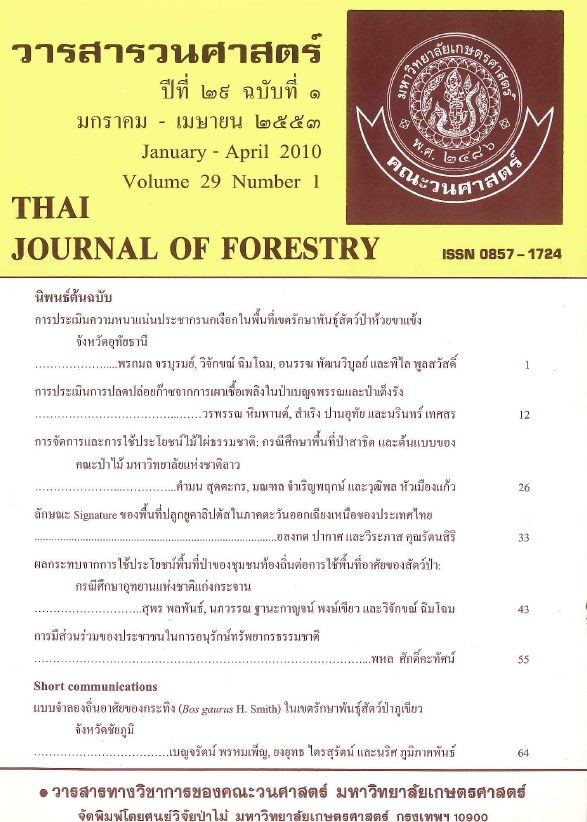แบบจำลองถิ่นอาศัยของกระทิง (Bos gaurus H. Smith) ในเขตรักษาพันธุ์สัตว์ป่าภูเขียว จังหวัดชัยภูมิ
Main Article Content
บทคัดย่อ
การศึกษาแบบจำลองถิ่นอาศัยของกระทิง (Bos gaurus H. Smith) ดำเนินการในเขตรักษาพันธุ์สัตว์ป่าภูเขียว จังหวัดชัยภูมิ มีวัตถุประสงค์เพื่อทำนายการกระจายของกระทิงและการคุกคาม โดยใช้ข้อมูลจากการลาดตระเวนและการสำรวจติดตามทรัพยากรธรรมชาติระหว่างเดือนเมษายน 2549 – ตุลาคม 2550 รวมระยะทางประมาณ 968 กิโลเมตร สร้างแบบจำลองถิ่นอาศัยที่เหมาะสม ด้วยโปรแกรมสำเร็จรูป Biomapper และปัจจัยด้านนิเวศ 9 ปัจจัย พบร่องรอยการปรากฏของกระทิง 562 จุด และปัจจัยคุกคาม 816 จุด ทดสอบความถูกต้องและประเมินคุณภาพของแบบจำลองความต้องการด้านนิเวศ (ecological niche factors analysis-ENFA) ด้วยชุดข้อมูลทดสอบ โดยวิธีการหาพื้นที่ใต้กราฟของ receiver operating characteristic (ROC) และเปรียบเทียบอัตราการเปลี่ยนแปลงการใช้พื้นที่ระหว่างฤดูแล้งและฤดูฝน ผลการศึกษาพบว่าจากข้อมูลรวมทั้งปีมีพื้นที่ที่มีความเหมาะสมสูงของกระทิงทั้งหมดเท่ากับ 260 ตารางกิโลเมตร คิดเป็นร้อยละ 16.56 ของพื้นที่ทั้งหมด โดยในฤดูแล้งและฤดูฝนมีพื้นที่ที่มีความเหมาะสมสูงเท่ากับ 221 และ 214 ตารางกิโลเมตร ตามลำดับ พื้นที่ที่มีการคุกคามระดับสูง (high threat intensive) เท่ากับ 317 ตารางกิโลเมตร คิดเป็นร้อยละ 20.23 ของพื้นที่ทั้งหมด ค่าพื้นที่ใต้กราฟของกระทิงในฤดูแล้งและฤดูฝน มีค่าเท่ากับ 0.68 และ 0.72 ตามลำดับ จัดว่าเป็นแบบจำลองที่ยอมรับได้ สามารถนำไปใช้ทำนายการกระจายของกระทิงในเขตรักษาพันธุ์สัตว์ป่าภูเขียวได้ ผลการวิจัยครั้งนี้เป็นประโยชน์ต่อการเสริมสร้างประสิทธิภาพการอนุรักษ์ประชากรกระทิงในเขตรักษาพันธุ์สัตว์ป่าภูเขียว และพื้นที่อนุรักษ์อื่นๆ ได้
คำสำคัญ: กระทิง แบบจำลองถิ่นอาศัย การวิเคราะห์ความต้องการทางด้านนิเวศ ข้อมูลที่มีเฉพาะการปรากฏ
Downloads
Article Details

อนุญาตภายใต้เงื่อนไข Creative Commons Attribution-NonCommercial-NoDerivatives 4.0 International License.
ข้าพเจ้าและผู้เขียนร่วม (ถ้ามี) ขอรับรองว่า ต้นฉบับที่เสนอมานี้ยังไม่เคยได้รับการตีพิมพ์และไม่ได้อยู่ในระหว่างกระบวนการพิจารณาตีพิมพ์ลงในวารสารหรือสิ่งตีพิมพ์อื่นใด ข้าพเจ้าและผู้เขียนร่วม (ถ้ามี) ยอมรับหลักเกณฑ์และเงื่อนไขการพิจารณาต้นฉบับ ทั้งยินยอมให้กองบรรณาธิการมีสิทธิ์พิจารณาและตรวจแก้ต้นฉบับได้ตามที่เห็นสมควร พร้อมนี้ขอมอบลิขสิทธิ์ผลงานที่ได้รับการตีพิมพ์ให้แก่วารสารวนศาสตร์ คณะวนศาสตร์ มหาวิทยาลัยเกษตรศาสตร์ กรณีมีการฟ้องร้องเรื่องการละเมิดลิขสิทธิ์เกี่ยวกับภาพ กราฟ ข้อความส่วนใดส่วนหนึ่ง หรือ ข้อคิดเห็นที่ปรากฏในผลงาน ให้เป็นความรับผิดชอบของข้าพเจ้าและผู้เขียนร่วม (ถ้ามี) แต่เพียงฝ่ายเดียว และหากข้าพเจ้าและผู้เขียนร่วม (ถ้ามี) ประสงค์ถอนบทความในระหว่างกระบวนการพิจารณาของทางวารสาร ข้าพเจ้าและผู้เขียนร่วม (ถ้ามี) ยินดีรับผิดชอบค่าใช้จ่ายทั้งหมดที่เกิดขึ้นในกระบวนการพิจารณาบทความนั้น”


